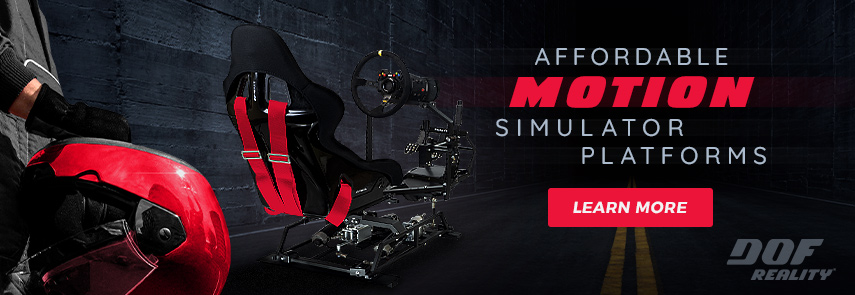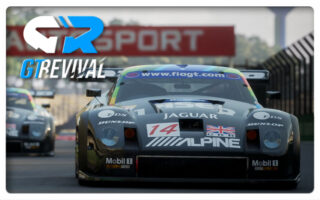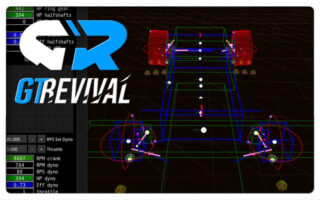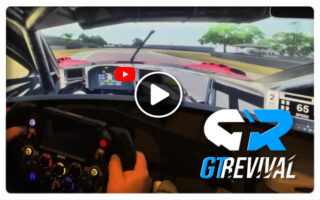Ian Bell came a long way since the early days of sim racing, when in 2001 he co-founded the SimBin modding team which produced a number of successful free add-ons for various racing games, culminating in the highly popular GTR2002 mod. The SimBin modding group, later on, became the foundation for the famed SimBin Studios known for the awesome GTR series. In 2009 Ian Bell founded Slightly Mad Studios which became the award-winning team behind the popular Project CARS franchise powered by Slightly Mad Studios fantastic in-house Madness game engine.
At the end of 2022, Ian Bell announced that he founded a new studio branding named Straight4Games or just plain Straight4. The new company announced a Strategic Partnership with German-Austrian media publisher and distributor PLAION, (formerly known as Koch Media GmbH). At this point Straight4 had revealed they were working on a new racing simulation with the project name GTR Revival, now GTRevival which should become available for the PC, PlayStation 5, and Xbox Series X|S platforms.
Now Tim Wheatley, Jon Denton, and Simon Croft recorded a new Race Sim Central podcast interviewing Straight4 CEO Ian Bell, to talk about the Straight4 Game Studio, the talents that work there, and the racing title they are creating. ( You can either check out the above audio recording of the podcast, or check out the edited written version of the interview below.
Quote: RSC Interview with Ian Bell:
Do you ever sit back and think about yourself in the late-’90s working out of a bedsit in London, and did you ever imagine you’d have almost a dozen best-selling sims to your name two decades later?
IAN BELL: Yeah, I do. When I started, back in the ’90s, the idea was to get a like-minded group of people together to make a mod and be able to go racing something that we would enjoy driving. There were actually a few F1 games out at that point—there was one by Ubisoft, I believe it was F1 Racing Simulation, there was Grand Prix II, by Jeff Crammond, and, yeah, there were things like Johnny Herbert’s Grand Prix Championship, so it seemed as if the F1 license wasn’t that exclusive at that point. We concluded that GT-racing might be an interesting modification to what was out there. So we took the wonderful work from ISI’s F1 2002 and made a total conversion model of it.
I was doing my third PhD on human computer interaction at the time, and I felt that it fitted the zeitgeist of my life. So, as I said, I set up a forum with the notion of attracting like-minded people who would be interested in doing something similar, many of whom are still with me, and some of whom have retired. (I’m getting old!) We eventually did a mod and we followed it up with another mod that became the “Mod of the Century”, I think by sheer luck because, you know, it was developed literally at the end of the century!
We did something very, very decent, though, looking back at it. And we had people come onboard then like, for example, the physics were done by Doug Arnao who still works with us, and many of the graphic artists are still here, too. I didn’t think it would become as big as it did. My idea then was that I would become a lecturer in psychology and, you know, earn maybe 60- or 70,000 a year if I was lucky. But that was fine. And, you know, being a professor—I was in my late-twenties—was something special. I was giving lectures each week, two or three, and yeah, it felt pretty good, and I think the students enjoyed it. Maybe they didn’t learn that much from it, but they enjoyed it because we had fun and fun has been my modus operandi the whole way through—enjoy yourself, make sure you enjoy what you’re doing. But as I did more of the mod work, I realized I was enjoying this stuff much more than I was enjoying writing theses.
That mod eventually became GTR – FIA GT Racing in 2005. But which is the sim that you’re most proud of?
IAN BELL: Well, GTR was seminal, but I’d have to say Project CARS because, yeah, with GTR, the funding came from elsewhere, and with Need for Speed: SHIFT, the funding came from EA, but with the Project CARS series, we had to find funding on our own. Back then, we had no funds, we had no publisher, we didn’t really have the cash in the bank, and I came up with the notion of WMD, and that’s what paid for the game. So from that perspective, we got our own cash, and we got complete freedom. There was no publisher intervention, and we weren’t curtailed in what we could do. So we went hell for leather and decided to do whatever we thought might be the best thing in terms of racing simulation. I’m not saying that Project CARS or Project CARS 2 were perfect in any way because I do think we bit off more than we could chew, but I’m most proud of that because that came from zero. As I say, no funding. I created the funding model and created the concept for the game, created the name, came up with the whole thing. My personal pride is fairly high for that one for sure.
There’s always something visceral about games that come from your studios. Is that something that you personally focus on?
IAN BELL: Yeah, I harp on about that constantly, and that applies to every single aspect of the game. It’s extremely difficult to transpose things like g-forces into a game. I mean, you can get the movable simulators that you sit in, and they give you a hint of g-forces moving this way and that, but it’s divorced from reality. It’s more of an indication, a very subtle indication.
So, what we did was, we worked on things like head physics and degrees of force feedback spring rates. We’re still working on that, to get it perfect, because you can overdo it and induce nausea if you get too much movement. For instance, when you’re braking, your head moves forward, and accelerating, your head comes back a little bit. But if you’re in a cockpit with a proper seat with head restraints using the HANS device, there’s not that much movement. So you need those subtle feedback mechanisms. And this is something that we’ve always tried to encapsulate within the game and something that I keep banging on about because it’s crucial.
It’s what I would call the “third party aspects”, where you have coiled wires moving, and the protective mesh on the windscreen moving, you have all of those things indicating g-forces and, you know, our next work is going to, well, I don’t want to give away too much, but we’re planning to do things where it’s completely linked to g-force, and you see the degree of movement based on that. I’m a psychologist by training and all those things have a psychological impact, even if it’s subconscious; you feel it, you believe it, you understand it, you feel immersed in it, and that’s where I want to go.
Project CARS 3 was perhaps not the most shining moment of your career. Can you discuss what happened there?
IAN BELL: Project CARS 3 is the one game that I didn’t directly input the minutia. Every game leading up to that I was directly involved in, and would drive the car constantly, feedback constantly. But during the Project CARS 3 development, I stepped back and, once we were taken over by Codemasters, I was advised to stop being involved in the micro details completely. I’m not sure that was an overall positive. Additionally, we didn’t want to call it Project CARS 3 at all. I sat around the table with twenty other people at Codemasters and openly stated that we wanted to call it Project CARS Sideways, giving the community an indication that we’re going off in a different direction, to have sort of semi-open-world areas.
The idea was that we’d go in a Forza Horizon direction as compared to Forza Motorsport. I was overruled, and I was overruled because I was told that the investors were insisting that we called the game Project CARS 3 because that’s what would sell. That decision was completely against my remit, completely against my advice, and something that I didn’t agree with. So that’s not a game I’m proud of. And that’s not a get-out, either. I did my best to try to at least change the name. I did my best to try to position it such that it would be more of Forza Horizon as opposed to a Forza Motorsport. You know, we sometimes must accept these decisions because the investors are paying insane amounts of money to make these things happen.
But you’re now going back to your roots? Simulation?
IAN BELL: One hundred percent. So I had a chat with Klemens (Kundratitz) at PLAION, and we’re as close to friends as you can be in the industry—he’s a great guy and I’m very happy to be working with him directly. He’s the one I communicate with, he’s the CEO there, and he’s given me my freedom and I do what I want to do now. So what we’re doing is going back to the vision of GTR2 and Project CARS 2. But this time more focused because with Project CARS 2, we had so much variation, an insane amount of variation and with insane variation comes an insane amount of balancing required, and it was effectively open-ended. So we weren’t able to balance everything to the level of perfection. It’s almost impossible with the amount of varied terrain, varied weather, varied humidity, varied everything, it’s almost impossible to make sure the balance is perfect for the AI. We will have a massive amount of content for GTRevival, but that content will be focused on what we’re absolutely best at, and we expect to come out with all guns blazing and do something extremely special and raise the bar for the industry.
A lot of the team has been with you for a quarter of a century now. How do you end up retaining staff for that amount of time, especially in the gaming industry where people move around a lot? And why bring in a Game Designer with no credits to his name? What was the thinking there?
IAN BELL: Going back to staff retention, look, it’s very simple. Don’t bullshit. Don’t lie to them, tell them the truth, tell it to them upfront, be straight, be honest. Most people who join a new company, they give you a certain introductory period where they’ll analyse you, they’ll analyse your behaviour, they’ll see if you’re being straight with them, and they’ll appreciate the fact that you’re being straight with them.
As for Austin, our new Game Designer, it’s like this: For five or six years, he was whinging about all of the shortcomings of our games. And my perspective was, “Well, look, put your mouth where your money is,” and that’s effectively what he’s done. And in my opinion, he’s turned out to be a wonderful designer. He’s extremely prolific. The detail with which he writes up his game design is from a perspective of hardcore sim-racing, and he has the expectation that we can deliver. If anything, we have to curtail him to an extent because he reaches for the stars. He’s pushing for the absolute limit in every area. You know, normally in this industry, we all try to pick our battles, we’ll go for one major USP and three micro USPs. And we’ve followed that mantra for quite a long time. But with Austin, you know, he’s not just the dreamer, he’s someone who actually does race, he races on ovals, and he knows his stuff and his feedback has been fantastic.
Do you detect a difference in the way he works, because obviously Austin is 29. You’ve been in the industry since he was about six years old.
IAN BELL: Right. Now that’s a depressing thing. Well, he has that energy of youth and it’s something that we should aim for, which is sim racing perfection, but that’s not possible. No one can do it over a single game, not even over multiple games. But the fact that he’s driving it and pushing it and asking for these design elements, I think that’s crucial because it drives the team forward as well, and they’re aiming to reach that very high-quality bar.
I think we have a wonderful mix of the old timers in here too, none of whom are jaded. When I spoke to them all about coming onboard Straight4, there was a palpable excitement. They came because they wanted to and it’s not that I’m paying the highest salaries in the world. We have a good environment, can work from home, they’re free, they’re flexible, they’re not being overly pressed. But yeah, you know, we have a good mix but, if we stayed only with the core team, they wouldn’t be big enough in terms of pure capacity to be able to deliver on the quality bar that’s required these days because the quality has increased so much.
These little details that are coming through these days, you can’t get away with anything shoddy, you need to work your ass off and make sure that everything is detailed and absolutely precise. And that means additional work and you need a mixture of good solid people who are aware of what they’re doing and who have the experience mixed with people who are young, maybe slightly more energetic, who are coming in with fresh ideas. Both these things are important.
There’s a bit of irony to be enjoyed by the sim racing community watching mostly console arcade racers now talking about physics models and tyre models and stuff that the sim community have been talking about for the last 20 years. In your opinion, have players just become a little tired of arcade games and turning toward simulation?
IAN BELL: Well, there are five million arcade games that all handle almost identically and, when you have that, you know, people become jaded because they’re feeling the same handling from one car to the next. What we are running with is SETA2, which is our new tyre model. It’s written from scratch from the ground up for our next sim. It’s an advancement on what we had with Project CARS 2. We’re making it more efficient as well, so it runs faster, but the machines are getting more powerful as well, so that helps us and, from my perspective, I’m fairly confident we’re going to come through with something that feels properly next gen’. It’s not a reuse of anything that’s gone before—we’re not using Terence Groening’s suspension model that’s been in every ISI-based sim for the last 20 years or whatever. We’re doing that ourselves. All of the physics we’re doing ourselves so it’s pretty advanced and we have a fantastic team working on that stuff and they’re doing a great job.
You don’t tend to hold back much on social media and forums and what not. Has this got you into trouble?
IAN BELL: Possibly, but if telling the truth gets me into trouble, then I’ll accept the trouble. Look, if people see me in person and if they see me online and they see my face, they’ll understand that I’m smiling through most of this. For me it’s a jolly. It’s about enjoying myself and having fun. And at the end of the day, regardless of how hardcore we get, if we’re not having fun, I have no interest in doing it. I don’t need to do this work. I love doing this work. I don’t need the money. I have enough of it. It’s completely fun for me, and it’s always been that way. I’m blessed. And yes, if people saw my face while I was typing—because you can’t put that into typing—they would see that I’m having fun. I’m having a smile. I’m not necessarily serious. But if you got to type “I’m not completely serious with this,” that’s, you know …
But the vast majority of what I say, I absolutely mean … at the time of typing it! Because the thing is, the internet doesn’t really work on temporality very well. You know, people will read something you’ve written 7 years ago, which at that time was absolutely spot-on, but with the benefit of hindsight became, “Oh, that didn’t happen”. Well, yeah, that’s life. We don’t get everything we dream of.
Is that why you started a new studio? It would have been easier for you to sail off into the sunset after all the success, right?
IAN BELL: I love what I do. I absolutely believe that we can raise the bar with the right people at the studio. I particularly enjoy creating great simulations. We never reached the multiplayer quality that iRacing produced. And I don’t think we reached the graphical acuity and quality of Gran Turismo. And what I want to do is be the best in every area. That’s my aim and that’s an unfulfilled dream. So it’s something that I’m driving for. That’s the motivation, that’s the main motivation to keep pushing in that direction. You can never win every single battle. But hey, you know, what’s the point if you’re not trying?
Is there a plan for some sort of early access or WMD to bring back the community early so that they can see what the studio is working on?
IAN BELL: Absolutely. Yes. We’re going to have WMD in a slightly modified form and we’re going to be embracing the community and we’re going to put it right there in front of them. They can have a look at it. They’ll be signing NDAs of course, but the core people that join us will see what we’ve got, and we will listen carefully to their feedback, and we will modify things as appropriate. But we are working from first principles here. We’re getting data from multiple tyre manufacturers now, so the tyre model is getting better and better. We’re getting much more feedback in terms of suspension, the physical ramifications of it and how they affect the car. And that’s all coming to us. So having those first principal data sets is extremely important and that’s where we’re building things now. I think everyone will enjoy it.
Is there a time frame for WMD?
IAN BELL: I’d like it to be a nice Christmas present to bring people onboard, but I want people to be invested. And when I say invested, I mean, psychologically invested, so that will require, maybe an early access payment—not that we need the cash. But I want to ensure that people are actually motivated and they’re in for the right reasons. We had that with Project CARS 2, and I think the sim was all the better for it.
Official Webpage – straight4.com
 Bsimracing Sim Racing Resources and News for the racing enthousiast.
Bsimracing Sim Racing Resources and News for the racing enthousiast.







